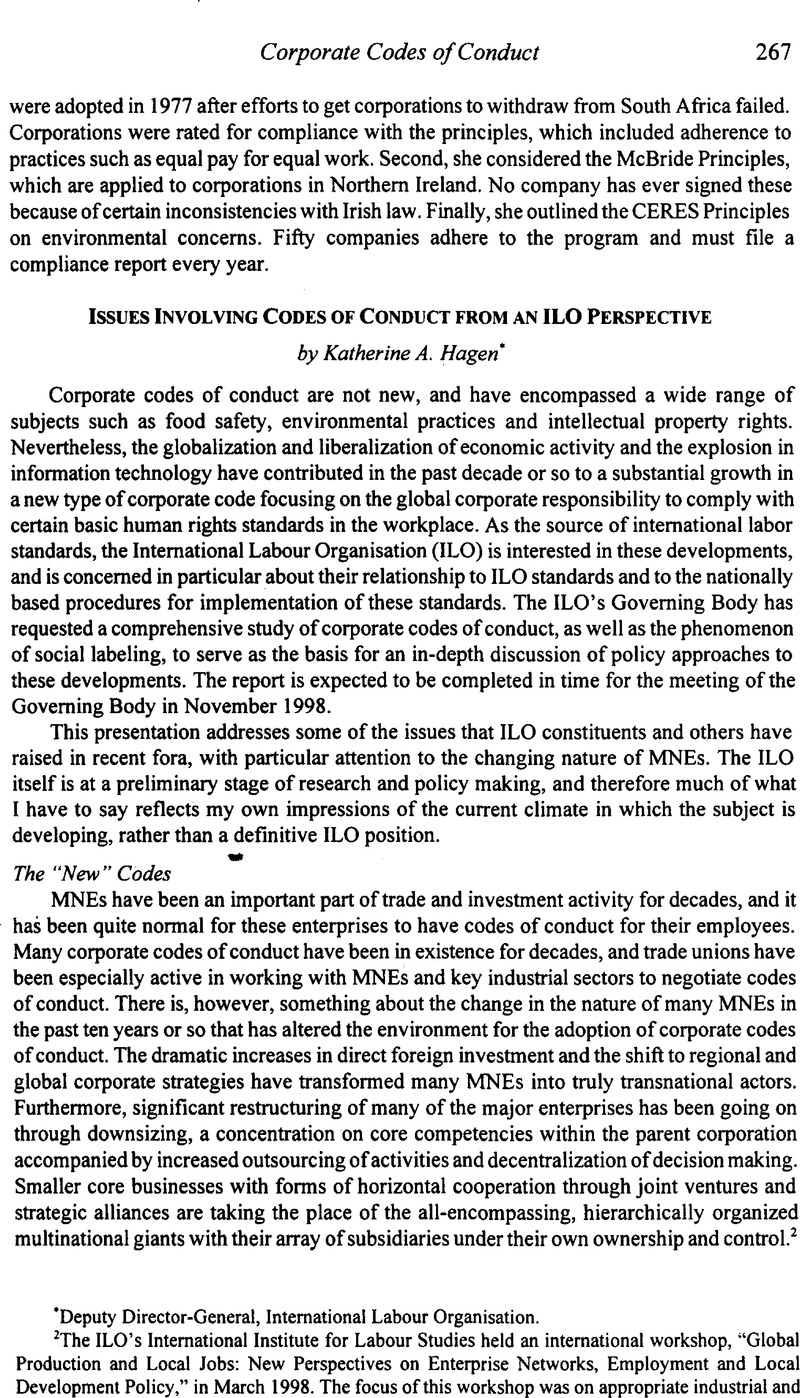No CrossRef data available.
Article contents
Issues Involving Codes of Conduct from an ILO Perspective
Published online by Cambridge University Press: 28 February 2017
Abstract

- Type
- Corporate Codes of Conduct
- Information
- Copyright
- Copyright © American Society of International Law 1998
References
2 The ILO’s International Institute for Labour Studies held an international workshop, “Global Production and Local Jobs: New Perspectives on Enterprise Networks, Employment and Local Development Policy,” in March 1998. The focus of this workshop was on appropriate industrial and social policies responsive to changing production systems and labor market outcomes. Papers on state-of-the-art research were shared with participants, and the results will be published early in 1999 by the Institute.
3 There is an excellent analysis of these developments in one of the papers at the international workshop noted above, prepared by G. van Liemt: The Social Policy Implications of Codes of Conduct, with Particular Reference to the Relations between Companies Adopting Such Codes and Their Suppliers and Subcontractors (available through the International Institute for Labour Studies, 4 route des Morillons, CH-1211 Geneva 22, Switzerland).
4 The Levi Strauss code of conduct is described in considerable detail in a recent study done for the ILO: J.P. Sajhau, Business Ethics in the Textile, Clothing and Footwear (TCF) Industries: Codes of Conduct (1997).
5 The EU-U.S. Labor Symposium in Brussels on Codes of Conduct and International Labor Standards, held in February 1998, involved a discussion of best practices and an exchange of information about different initiatives in the United States and the EU.
6 The OECD Declaration and Decisions on International Investment and Multinational Enterprises, 1991 REVIEW, OECD, Paris, 1992, at 38. The ILO may well have been influenced by what the OECD covered in deciding what to include in its own Tripartite Declaration. The OECD Declaration emphasizes the right to freedom of association and provides for access to information on the performance of the enterprise, comparable standards to those observed by other employers in the host country, training and upgrading of the local labor force, advance notice of layoffs, nondiscrimination, and no threats to transfer operating units or employees to influence unfairly any bona fide negotiations with employee representatives on conditions of employment. It continues to be a useful document within the OECD and was “attached” to the recently negotiated draft of a proposed Multinational Agreement on Investments. Nonetheless, the Tripartite Declaration is far more detailed and covers more issues than the OECD’s Declaration, and the OECD has determined that “the ILO Declaration of Principles informs the OECD Guidelines to the extent that the Principles provide a greater degree of elaboration on standards of behavior of MNEs” (1991 REVIEW at 52).
7 ILO, Tripartite Declaration of Principles Concerning Multinational Enterprises and Social Policy (2d ed. 1991). This document has now been published in more than thirty languages.
8 Id. at 2, para. 2.
9 The ILO and others have, in fact, focused much attention on codes of conduct (and also labeling programs) in terms of the global campaign against child labor. A major impetus for further debate and review of the overall issue was the High-Level Informal Ministerial Level Dialogue on Child Labor at the June 1996 Conference of the ILO, which led to the study CHILD LABOUR SOCIAL LABELLING: A PRELIMINARY STUDY, written by Janet Hilowitz for the ILO and published later that year. It is also the focus of the forthcoming HANDBOOK ON CHILD LABOUR: A GUIDE FOR ACTION, which is being prepared by the International Organization of Employers in collaboration with the ILO.
10 See International Labour Office, Governing Body, Third Item on the Agenda, Follow-up on the Discussion of the Report of the Director-General to the 85th Session (1997) of the International Labour Conference, GB270/3/2, 270th Sess., Geneva, Nov. 1997, which served as the basis for the Governing Body’s debate in November. The Minutes of the Governing Body for the 270th Session provide a short summary of the debate. See International Labour Office, Governing Body, Minutes of the 270th Session, GB.270/PV (Rev.), 270th Sess., Geneva, Nov. 1997, at IV/l-IV/2.
11 Jayanti Durai, Helping Business to Help Stop Child Labour, A Report by Anti-Slavery International (Mike Dottridge ed., 1997).
12 The proposed Declaration is a means of reaffirming the presence of a universally recognized core set of fundamental principles and objectives that flow from the ILO’s Constitution, as follows: “(1) ensuring the promotion of freedom of association and the effective recognition of the right to collective bargaining; (2) constantly seeking to suppress all forms of forced or compulsory labour, exacted under the menace of any penalty and for which workers have not offered themselves voluntarily; (3) pursuing its efforts towards the effective abolition of child labour, progressively raising the minimum age for admission to employment or work to a level consistent with the fullest physical and mental development of young persons; and (4) bringing about the conditions for true equality of opportunity among all workers, especially male and female workers, through the elimination of discrimination in respect of employment and occupation in all its forms” (GB 271/3/1, March 1998).


